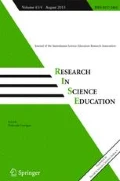Abstract
The aims of the junior technical schools in Victoria were, from the time of their formal establishment in 1911, to provide preparatory education-training for two groups. First, for the relatively small number who proceeded to higher technical education, appropriate for industrial chemists, engineers and architects, and secondly, for the relatively larger numbers who sought to enter skilled trades. The first successful campaign in Australia for a general science for all other secondary students in Victoria was waged in the War years 1939–43 on a platform of science as “a badge of utility and a key to good citizenship”. These were the modest terms upon which science teaching secured a more central place in the classical literary curriculum. The final campaign twenty years later in technical schools was fought on the platform that school science was “not just a servant to trade or engineering courses.”
Similar content being viewed by others
References
Australian Academy of Science. (1967).The web of life. Canberra: Australian Academy of Science.
Australian Labor Party. (1964).Looking to the future: Labor's plan for education in Victoria. Melbourne: Keeble
Burnett, R. (1944). The science teacher and his objectives.Teachers College Record, 45(4), 25–43.
Bruner, J. (1966).Toward a theory of instruction. Boston: Harvard University Press.
Butts, F. (1955).Assumptions underlying Australian education. Melbourne: Australian Council for Educational Research.
Cremin, L. (1961).The transformation of the school: Progressivism in American education, 1876–1957. New York: Knopf.
Cohen, D. (1964).The development of an Australian science curriculum model. Unpublished PhD thesis, Michigan State University.
Cohen, D., & O'Neill, B. (1966).Science through activity. Melbourne: Cheshire.
Cuban, L. (1984).How teachers taught: Constancy and change in American classrooms, 1890–1980. New York: Longman.
Duncan, J., & Starling, S. (1918).A textbook of physics. London: Macmillan.
Education Department of Victoria. (1967).Students at intake. Survey and Planning Branch Document A. 67/444. Melbourne: Department of Education, Victoria.
Eltham, E. (1945).Technical education in war and peace. Melbourne: Institute of Industrial Management of Australia.
Fabinyi, A. (1966). The Australian book. In C. Semmler & D. Whitlock (Eds.),Literary Australia. Melbourne: Cheshire.
Fawns, R. (1985). Negotiating an Australian general science-the professional dilemma 1939–45.Research in Science Education, 15, 166–176.
Fawns, R. (1987). Clear thinking and scientific method for our future leaders.Research in Science Education, 17, 67–77.
Fawns, R. (1988).The maintenance and transformation of school science. Unpublished PhD thesis, Monash University, Victoria.
Fawns, R. (1989). “Coping with the modern world.” The context and debate at the Australian Science Education Project guidelines conference.Research in Science Education, 19, 76–87.
Fawns, R. (1990). Practicalising Piaget at the ASEP guidelines conference 1970.Research in Science Education, 20, 76–86.
Fawns, R. (1993). Stories tell but words conceal-aspects of historiographical research.Research in Science Education, 21, 74–82.
Fawns, R. (1993). John Turner and public education. In D. Ashton, & S. Ducker,John Stewart Turner 1908–1991. Historical records of Australian Science, 9(3,) 279–290.
Goodson, I. (1990).School subjects and curriculum change. London: Falmer Press.
Goodson, I., & Dowbiggin, I. (1991). Vocational education and school reform: The case of the London (Canada) technical school 1990–1930.History of Education Review, 20(1), 39–60.
Harris, M. (1973).The angry eye. Pott's Point: Pergamon.
Hogg, J. (1948). The content of education. InSpeeches at the conference of headmasters. Geelong: Geelong Grammar School, Corio.
Horne, D. (1964).The lucky country. Sydney: Penguin.
Hutchinson, R. (1930).Junior technical electricity. London: University Press.
Jackson, E. (1960). The teaching of science in technical schools. (Memorandum to Schools, October). Melbourne: Technical Schools Division.
Jenkins, E. (1978).From Armstrong to Nuffield. London: Murray.
Kliebard, H. (1986).The struggle for the American curriculum: 1890–1958. Boston: Routledge & Kegan Paul.
Layton, D. (1973).Science for the people. London: Allen & Unwin.
Lugg, D. (1968).Getting science across. Melbourne: Cheshire.
Martin, S., & Connor, A. (1945).Basic physics. Melbourne: Whitcombe & Tombs.
Messel, H., Crocker, R., & Barker, E. (1963).Science for high school students. Sydney: Nuclear Research Foundation.
Meyer, J. (1980). Levels of the educational system and schooling effects. In C. Bredwell & D. Winaham (Eds.),Analysis of education productivity (Vol. 2, Issues in macroanalysis.). Cambridge: Ballington.
Milburn, G., Goodson, I., & Clark, R. (1989).Reinterpreting curriculum records: Images and arguments. Lewes: Falmer Press.
Minister of Public Instruction. (1887).Annual report of the Bendigo School of Mines and Industry to the Minister of Public Instruction. Melbourne: Victorian Government Printer.
Murray-Smith, S., & Dare, A. (1987).The Tech-A centenary history of the Royal Melbourne Institute of Technology. Melbourne: Hyland House.
Reid, W. (1984). Curriculum topics as institutional categories: Implications for theory and research in the history and sociology of school subjects. In I. Goodson & S. Ball (Eds.),Defining the curriculum: Histories and ethnographies. London: Falmer.
Schrodinger, E. (1945).What is life? Cambridge: Cambridge University Press.
Stanhope, R. (1961). Recent developments in secondary school science courses in Australia.Australian Science Teachers Journal, 7(3), 24–38.
Technical Schools Division. (1961).Science syllabus. Melbourne: Education Department of Victoria.
Technical Schools Division. (1963).Leaving general science syllabus. Melbourne: Education Department of Victoria.
Technical Schools Division. (1964).Circular for principals of technical schools, revisions of science syllabus forms 1–4 (T64/620). Melbourne: Education Department of Victoria.
Technical Schools Division. (1966).Technical schools science part I: Form IV Syllabus. Melbourne: Education Department of Victoria.
Thomas, J. (1980 & 1984). Personal communication. (Taped interviews recorded and retained by the author).
Turner, J. (1943).General science for Australian schools. Books I and II. Melbourne: Oxford University Press.
Thomas, J. (1960–1965 a, b, c, d). Written correspondence with David Cohen held in the author's Technical Schools Archives.
Turner, J. (1965). Correspondence with Thomas held in the author's Technical Schools Archives.
Tyack, D. (1990). “Restructuring” in historical perspective: Tinkering toward utopia.Teachers College Record, 92(2), 45–59.
UNESCO International Advisory Committee on the School Curriculum. (1958).Curriculum revision and research. Paris: UNESCO.
Whipple, G. (1932). A programme for science teaching. In theThirty-first year book of the national society for the study of education. Chicago: University of Chicago Press.
Williams, R. (1971).Orwell. London: Fontana/Collins.
Author information
Authors and Affiliations
Corresponding author
Rights and permissions
About this article
Cite this article
Fawns, R. The struggle for general science in Australia: The final campaign in the technical schools of the state of Victoria. Research in Science Education 26, 1–22 (1996). https://doi.org/10.1007/BF02356960
Issue Date:
DOI: https://doi.org/10.1007/BF02356960




